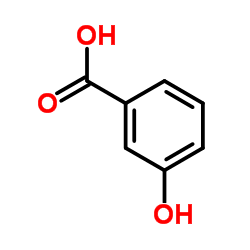3-Hydroxybenzoicacid

3-Hydroxybenzoicacid structure
|
Common Name | 3-Hydroxybenzoicacid | ||
|---|---|---|---|---|
| CAS Number | 99-06-9 | Molecular Weight | 138.121 | |
| Density | 1.4±0.1 g/cm3 | Boiling Point | 346.1±25.0 °C at 760 mmHg | |
| Molecular Formula | C7H6O3 | Melting Point | 201 °C | |
| MSDS | Chinese USA | Flash Point | 177.3±19.7 °C | |
| Symbol |

GHS07 |
Signal Word | Warning | |
|
Degradation of anti-inflammatory drug ketoprofen by electro-oxidation: comparison of electro-Fenton and anodic oxidation processes.
Environ. Sci. Pollut. Res. Int. 21(14) , 8406-16, (2014) The electrochemical degradation of the nonsteroidal anti-inflammatory drug ketoprofen in tap water has been studied using electro-Fenton (EF) and anodic oxidation (AO) processes with platinium (Pt) and boron-doped diamond (BDD) anodes and carbon felt cathode.... |
|
|
Antagonistic control of a dual-input mammalian gene switch by food additives.
Nucleic Acids Res. 42(14) , e116, (2014) Synthetic biology has significantly advanced the design of mammalian trigger-inducible transgene-control devices that are able to programme complex cellular behaviour. Fruit-based benzoate derivatives licensed as food additives, such as flavours (e.g. vanilla... |
|
|
DNA-Linked Enzyme-Coupled Assay for Probing Glucosyltransferase Specificity.
ACS Synth. Biol. 4 , 833-41, (2015) Traditional enzyme characterization methods are low-throughput and therefore limit engineering efforts in synthetic biology and biotechnology. Here, we propose a DNA-linked enzyme-coupled assay (DLEnCA) to monitor enzyme reactions in a high-throughput manner.... |
|
|
[3-hydroxybenzoate and 2,5-dihydroxybenzoate metabolism in Rhodococcus opacus 1CP strain].
Mikrobiologiia 81(3) , 325-31, (2012)
|
|
|
Direct analysis of salicylic acid, salicyl acyl glucuronide, salicyluric acid and gentisic acid in human plasma and urine by high-performance liquid chromatography.
J. Chromatogr. B, Biomed. Appl. 675(1) , 61-70, (1996) A method for the simultaneous direct determination of salicylate (SA), its labile, reactive metabolite, salicyl acyl glucuronide (SAG), and two other major metabolites, salicyluric acid and gentisic acid in plasma and urine is described. Isocratic reversed-ph... |
|
|
3D-QSAR and molecular docking studies of benzaldehyde thiosemicarbazone, benzaldehyde, benzoic acid, and their derivatives as phenoloxidase inhibitors.
Bioorg. Med. Chem. 15 , 2006-15, (2007) Phenoloxidase (PO), also known as tyrosinase, is a key enzyme in insect development, responsible for catalyzing the hydroxylation of tyrosine into o-diphenols and the oxidation of o-diphenols into o-quinones. Inhibition of PO may provide a basis for novel env... |
|
|
Click to a focused library of benzyl 6-triazolo(hydroxy)benzoic glucosides: novel construction of PTP1B inhibitors on a sugar scaffold.
Eur. J. Med. Chem. 46 , 4212-8, (2011) With an aim of developing novel protein tyrosine phosphatase (PTP) 1B inhibitors based on sugar scaffolds, a focused library of benzyl 6-triazolo(hydroxy)benzoic glucosides was efficiently constructed via the modular and selective Cu(I)-catalyzed azide-alkyne... |
|
|
MhbT is a specific transporter for 3-hydroxybenzoate uptake by Gram-negative bacteria.
Appl. Environ. Microbiol. 78(17) , 6113-20, (2012) Klebsiella pneumoniae M5a1 is capable of utilizing 3-hydroxybenzoate via gentisate, and the 6.3-kb gene cluster mhbRTDHIM conferred the ability to grow on 3-hydroxybenzoate to Escherichia coli and Pseudomonas putida PaW340. Four of the six genes (mhbDHIM) enc... |
|
|
Inhibition of 15-lipoxygenase-catalysed oxygenation of arachidonic acid by substituted benzoic acids.
Bioorg. Med. Chem. 16 , 4589-93, (2008) Elevated levels of phospholipases, prostaglandin synthases and lipoxygenases in colonic cells at various stages of malignancy indicate a strong link between dietary lipids and colon cancer. Lipoxygenase-catalysed arachidonic acid metabolism plays a key role i... |
|
|
A metabolite profiling approach to identify biomarkers of flavonoid intake in humans.
J. Nucl. Med. 139 , 2309-14, (2009) Flavonoids are phytochemicals that are widespread in the human diet. Despite limitations in their bioavailability, experimental and epidemiological data suggest health benefits of flavonoid consumption. Valid biomarkers of flavonoid intake may be useful for e... |